30 Stories for Sjögren’s Awareness
April is Sjögren’s Awareness Month. Sjögren’s is one of the most prevalent autoimmune diseases, affecting an estimated 4 million Americans. In our #ThisIsSjögrens online campaign, we are featuring 30 real patients to show the impact of this complex disease.
Every day in April, we will highlight a different patient to create a better understanding of the disease. While the daily posts will each give one small glimpse into living with Sjögren’s, by the end of April, we hope these 30 posts will help others understand that the disease is serious, systemic and prevalent.
We encourage you to follow our campaign and remember that every day is an opportunity to start a conversation about Sjögren’s and how it affects you. Together, we will conquer the complexities of Sjögren's!
Carrie Ann Inaba launches Sjögren's Awareness Month #ThisIsSjögrens
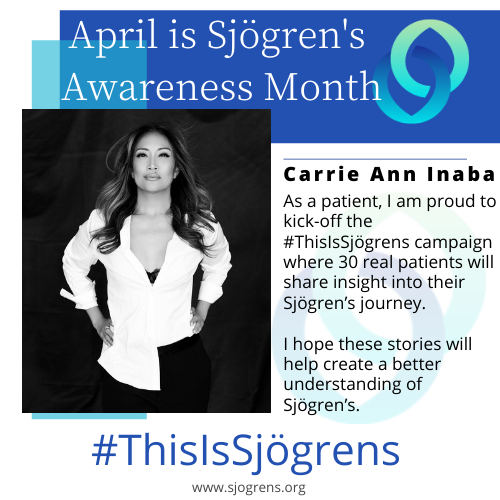
Day 1: Carrie Ann Inaba
As a patient, I understand the need to prioritize your health and how important it is to have a strong support system. Often described as an “invisible disease,” Sjögren’s affects patients differently and everyone has a unique and powerful story to share. I am proud to kick-off the #ThisIsSjögrens campaign where 30 real patients will share insight into their Sjögren’s journey. I hope these stories will help create a better understanding of this complex disease and let all patients know that there is support through this community.
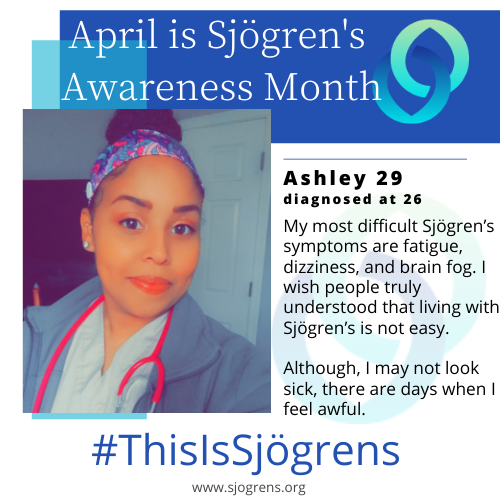
Day 2: Ashley 29 (diagnosed at 26)
My most difficult Sjögren’s symptoms are fatigue, dizziness, and brain fog. I wish people truly understood that living with Sjögren’s is not easy. Although, I may not look sick, there are days when I feel awful. Despite all the ups and downs that come with battling this chronic illness, it’s important to practice self-love.
Click here to learn more about living with Sjögren’s.
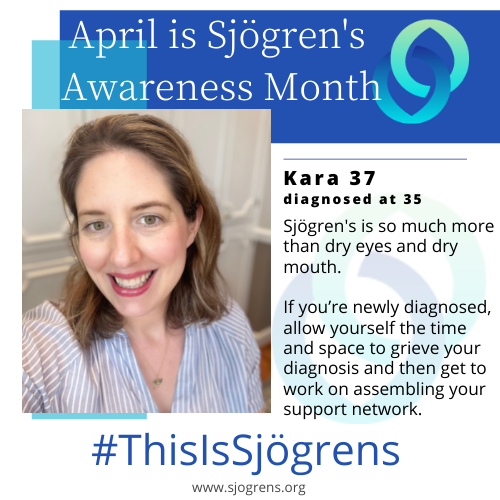
Day 3: Kara 37 (diagnosed at 35)
Sjögren's is so much more than dry eyes and dry mouth. This disease has taught me to slow down and savor life. If you’re newly diagnosed, allow yourself the time and space to grieve your diagnosis and then get to work on assembling your support network. Learning to ask for help when I need it, has been the biggest act of self-care I have learned.
Click here to learn more about being newly diagnosed with Sjögren’s.
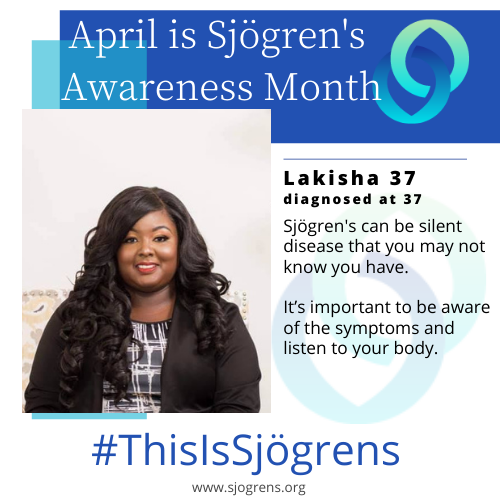
Day 4: Lakisha 37 (diagnosed at 37)
Sjögren's can be a silent disease that you may not know you have. It’s important to be aware of the symptoms and listen to your body. By recording your symptoms, you can better recognize them and learn what treatment options work for you.
Click here to view the Foundation’s Tracking Your Sjögren’s Symptoms Daily Work Sheet
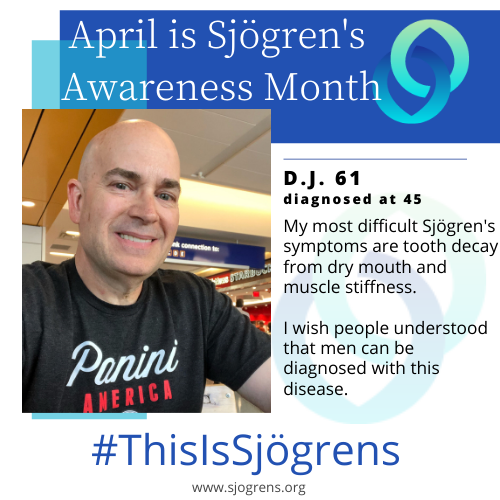
Day 5: D.J. 61 (diagnosed at 45)
My most difficult Sjögren's symptoms are tooth decay from dry mouth and muscle stiffness. I wish people understood that men can be diagnosed with this disease. My best Sjögren’s tip is that you can say no when it’s appropriate. Rest is often the best medicine when in a disease flare.
Click here to learn more about men with Sjögren’s.
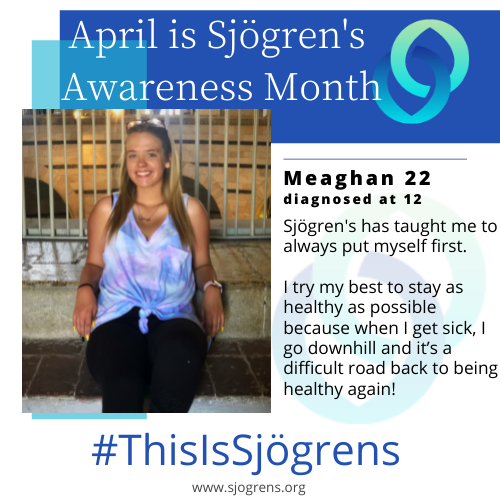
Day 6: Meaghan 22 (diagnosed at 12)
Having Sjögren’s from a young age has made a lot of things difficult. Growing up, I often couldn’t keep up with kids my age.
Sjögren's has taught me to always put myself first. I try my best to stay as healthy as possible because when I get sick, I go downhill and it’s a difficult road back to being healthy again!
Click here to learn more about Sjögren's in children.
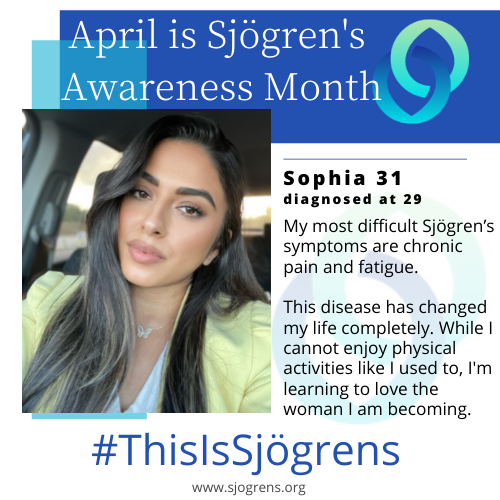
Day 7: Sophia 31 (diagnosed at 21)
My most difficult Sjögren’s symptoms are chronic pain and fatigue.
This disease has changed my life completely. While I cannot enjoy physical activities like I used to, I am learning to love the woman I am becoming.
Click here to learn more about Sjögren’s and fatigue.

Day 8: Jo 87 (diagnosed at 52)
Although I was diagnosed at 52, I believe I’ve had Sjögren’s for over 60 years. My best Sjögren’s tip is to find a knowledgeable rheumatologist, ophthalmologist, and a good support group!
Click here to learn more about Sjögren’s support groups
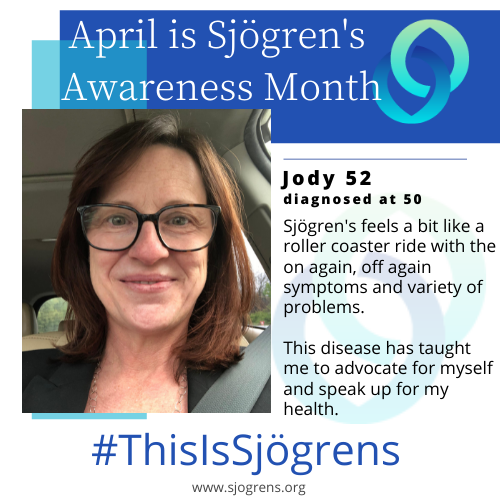
Day 9: Jody 52 (diagnosed at 50)
Sjögren's feels a bit like a roller coaster ride with the on again, off again symptoms and variety of problems. It is a lot to handle emotionally and physically. This disease has taught me to advocate for myself, not be afraid to ask questions and speak up for my health.
Click here to learn more about Sjögren's symptoms.
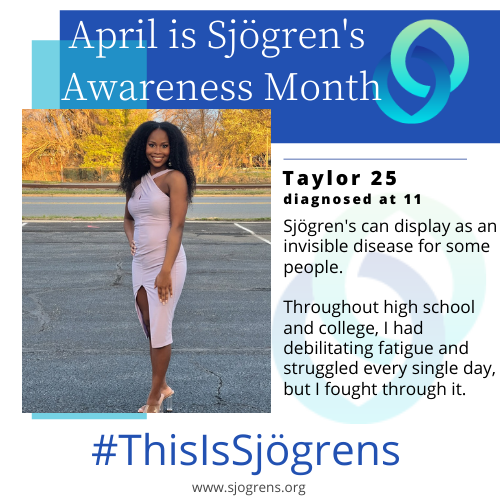
Day 10: Taylor 25 (diagnosed at 11)
Sjögren's can display as an invisible disease for some people. Throughout high school and college, I had debilitating fatigue and struggled every single day, but I fought through it.
I cope with my symptoms by actively advocating for a cure. Sjögren's has taught me that I am a conqueror and together we will conquer Sjögren's.
Learn more about how to join as a Foundation Member and add your voice to ours as we advocate for all patients.
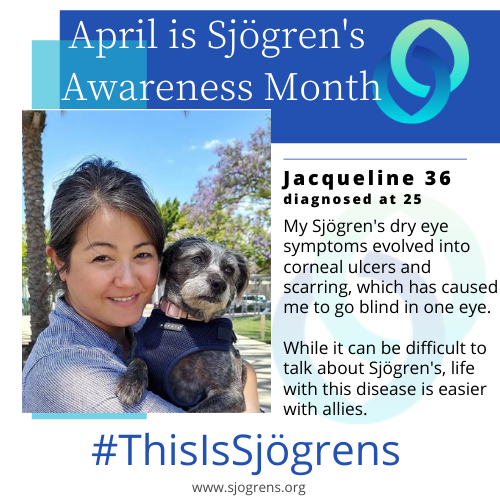
Day 11: Jacqueline 36 (diagnosed at 25)
My dry eye symptoms evolved into corneal ulcers and scarring, which has caused me to go blind in one eye. Sjögren's has taught me humility. I have limitations and that's okay.
I am often emotionally exhausted from the daily struggle of living in a body that is at war with itself. While it can be difficult to talk about Sjögren's, life with this disease is easier with allies.
Click here to learn more about the top 5 things your rheumatologist should be monitoring for.
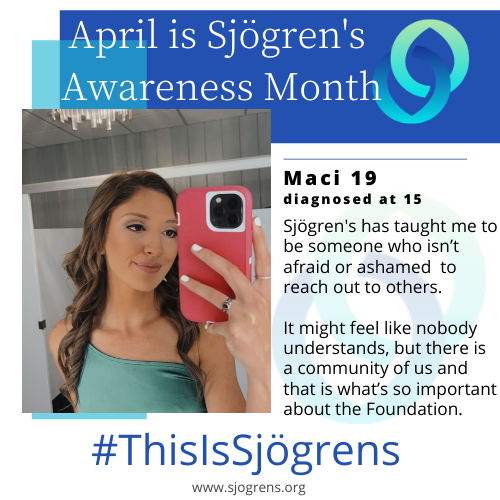
Day 12: Maci 19 (diagnosed at 15)
Sjögren's has taught me to be someone who isn’t afraid to reach out to others and isn’t ashamed to admit my internal flaws.
It might feel like nobody in the world understands, but there is a community of us who can relate and that is what’s so important about the Sjögren's Foundation.
Today is National Pediatric Sjögren's Awareness Day. Click here to learn more about Childhood Sjögren's.
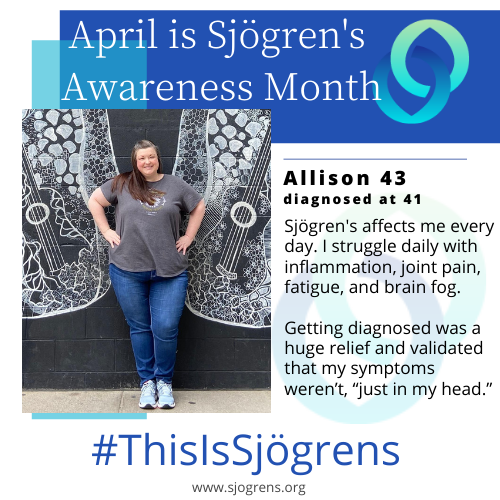
Day 13: Allison 43 (diagnosed at 41)
Sjögren's affects me every day. I struggle daily with inflammation, joint pain, fatigue, and brain fog. Getting diagnosed was a huge relief and validated that my symptoms weren’t, “just in my head.” Incorporating an anti-inflammatory diet has helped me.
Click here to learn more about Sjögren's and an anti-inflammatory diet.
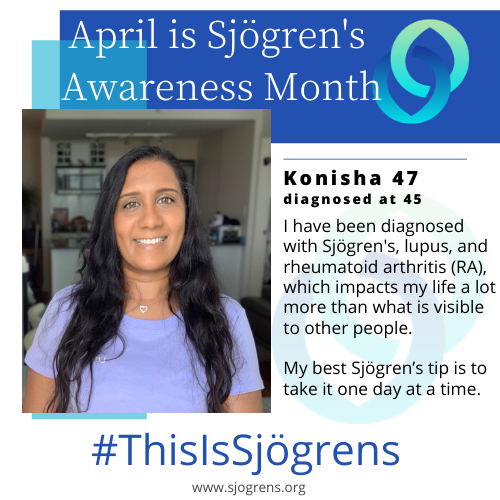
Day 14: Konisha 47 (diagnosed at 45)
I have been diagnosed with Sjögren's, lupus, and rheumatoid arthritis (RA), which impacts my life a lot more than what is visible to other people. My best Sjögren’s tip is to take it one day at a time.
Click here to learn more about overlapping diseases with Sjögren’s.

Day 15: Jennalee 33 (diagnosed at 25)
When I was pregnant, I was unaware of potential Sjögren's complications. My doctor had to frequently monitor the baby’s heart to ensure that if there was congenital heart block, it was caught and treated early.
I felt very unprepared for the additional testing and frequent monitoring during pregnancy. I hope I can bring raise awareness to this issue.
Click here to learn more about pregnancy and Sjögren's.
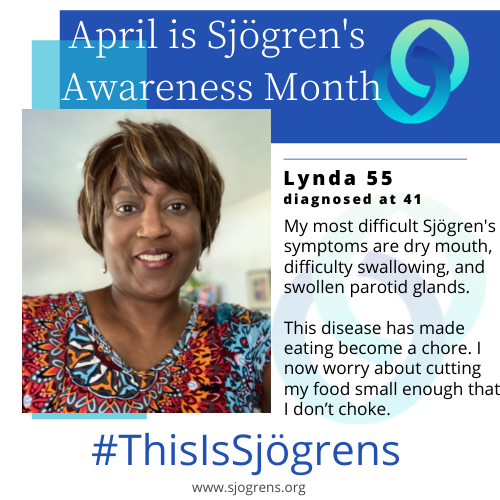
Day 16: Lynda 55 (diagnosed at 41)
My most difficult Sjögren's symptoms are dry mouth, difficulty swallowing and painful/swollen parotid glands.This disease has made eating become a chore. I now worry about cutting my food small enough that I don’t choke. I also need to bring water everywhere.
Click here to view the Sjögren's Foundation’s Patient Education Sheet on how to massage salivary glands and click here to view more Sjögren’s Patient Education Sheets.
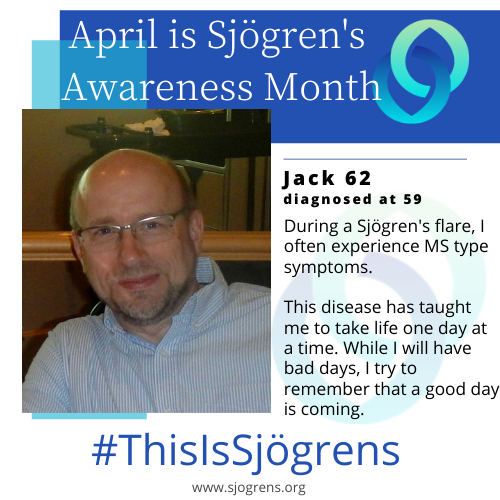
Day 17: Jack 62 (diagnosed at 59)
During a Sjögren's flare, I often experience MS type symptoms, such as numbness, tingling, pain, fatigue, and light sensitivity.
This disease has taught me to take life one day at a time. While I will have bad days, I try to remember that a good day is coming.
Click here to learn more about a Sjögren's flare.
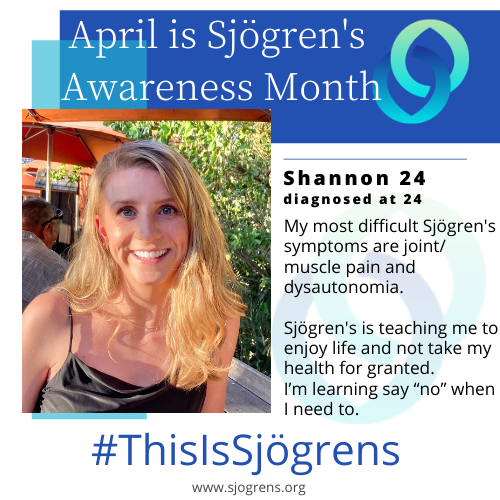
Day 18: Shannon 24 (diagnosed at 24)
My most difficult Sjögren's symptoms are joint/ muscle pain and dysautonomia. Sjögren's is teaching me to enjoy life and not take my health for granted. I’m learning say “no” when I need to, especially during a flare. My best tip is to find a good support system.
Click here to learn more about Sjögren's support groups, including special support groups.

Day 19: Niki 50 (diagnosed at 42)
My best Sjögren’s tip is to do your own research and be an advocate for yourself. Ask for what you need from family, friends, and healthcare providers. You’re worth it!
I wish people understood how this disease can often be invisible. If you know someone living with Sjögren’s, please be kind when they say they’re exhausted or cannot participate in something.
Learn more about Sjögren's by attending this year’s National Patient Conference.
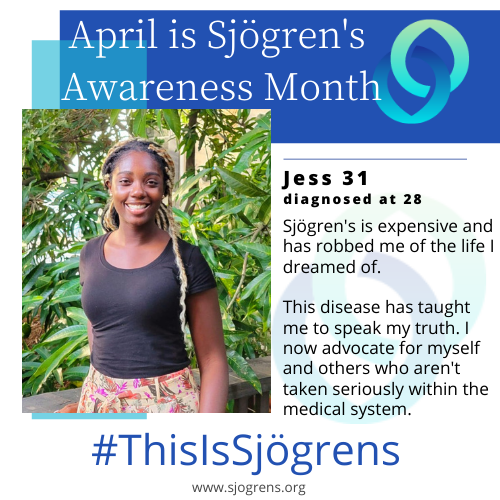
Day 20: Jess 31 (diagnosed at 28)
Sjögren's has robbed me of the life I dreamed of. It’s expensive to keep up with medications and diet to manage my symptoms.
I wish people knew that I’m in pain almost every single day, but this disease has taught me to speak my truth. I now advocate for myself and others who aren't taken seriously within the medical system.
Click here to learn more about nutrition to improve symptoms of Sjögren's.

Day 21: Tammy 52 (diagnosed at 50)
My most difficult Sjögren’s symptom is full body fatigue. Where it feels like lead weights are tied to you and you really can’t move.
Since being diagnosed, it has been difficult for others to understand my limitations. I wish people knew that I’m doing my best to listen to my body and get through each day.
Click here to learn more about Sjögren’s and fatigue.
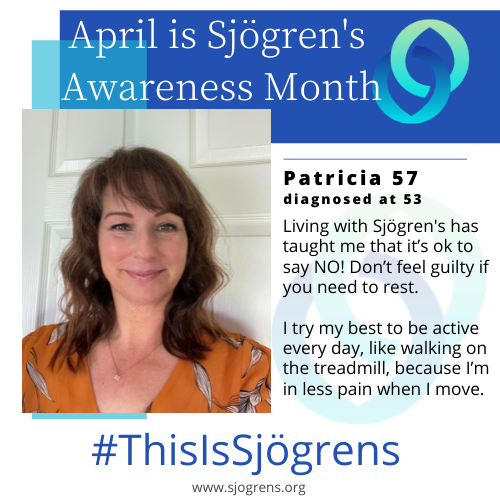
Day 22: Patricia 57 (diagnosed at 53)
Living with Sjögren's has taught me that it’s ok to say NO! Don’t feel guilty if you need to rest.
I try my best to be active every day, like walking on the treadmill, because I’m in less pain when I move. While I don’t complain, I wish people would ask me how I’m doing.
Click here to learn more about Sjögren's symptoms.
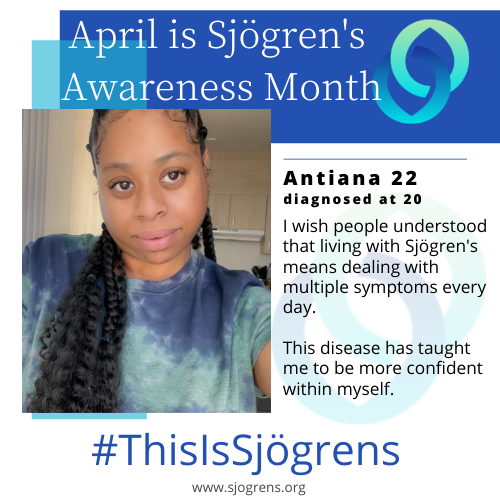
Day 23: Antiana 22 (diagnosed at 20)
I wish people understood that living with Sjögren's means dealing with multiple symptoms every day. While Sjögren's has impacted my life both physically and emotionally, this disease has taught me to be more confident within myself.
Click here to learn more about living with Sjögren’s.

Day 24: Timothy 53 (diagnosed at 46)
Sjögren's forced me to end my career as a Pennsylvania State Trooper and I am now on disability.
My best tip is to listen to your body and find support in family and friends. It’s important to enjoy what you can, without putting yourself into a disease flare.
Click here to learn more about disability & Sjögren's.
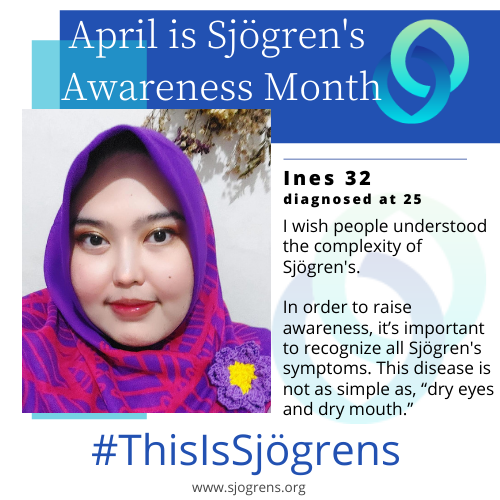
Day 25: Ines 32 (diagnosed at 25)
I wish people understood the complexity of Sjögren's. In order to raise awareness, it’s important to recognize all Sjögren's symptoms. It’s not as simple as, “dry eyes and dry mouth.”
Click here to view Sjögren's Brochures & Resource Sheets.
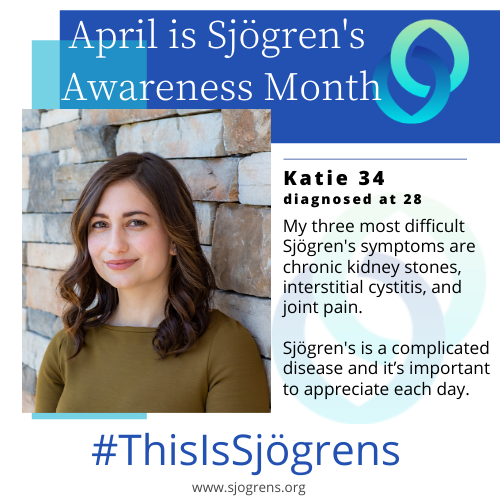
Day 26: Katie 34 (diagnosed at 28)
My three most difficult Sjögren's symptoms are chronic kidney stones, interstitial cystitis, and joint pain. Sjögren's is a complicated disease and it’s important to appreciate each day. Pilates has been a game changer for me. It helps with my joint pain and peripheral neuropathy.
Click here to learn more about Sjögren's Gynecology and Urology Tips.
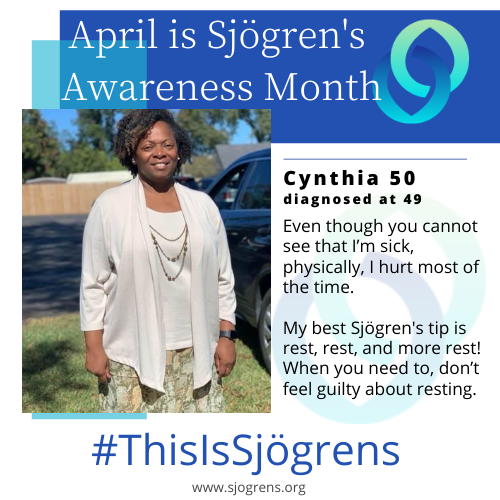
Day 27: Cynthia 50 (diagnosed at 49)
Even though you cannot see that I’m sick, physically, I hurt most of the time. My best Sjögren's tip is rest, rest, and more rest! When you need to, don’t feel guilty about resting.
Click here to view Sjögren's survival tips.
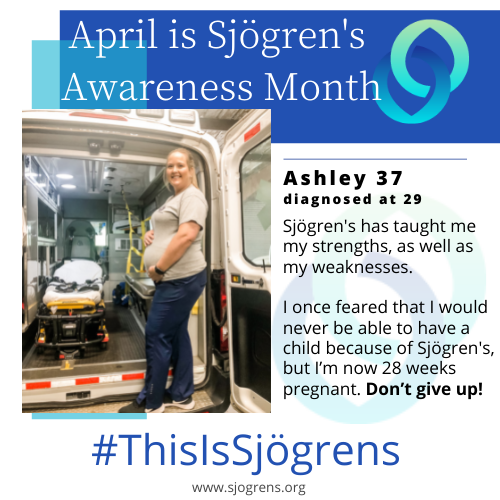
Day 28: Ashley 37 (diagnosed at 29)
Sjögren's has taught me my strengths, as well as my weaknesses. My job as a Paramedic is very demanding, and I’ve learned to manage my time/rest. I once feared that I would never be able to have a child due to Sjögren's, but I’m now 28 weeks pregnant with a healthy baby boy. Don’t give up!
Click here to learn more about pregnancy and Sjögren's.
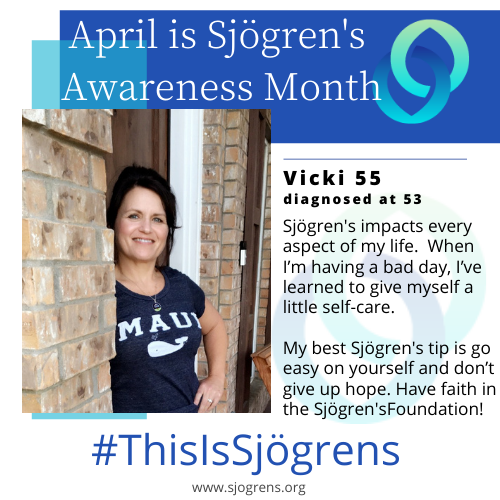
Day 29: Vicki 55 (diagnosed at 53)
Sjögren's impacts every aspect of my life. When I’m having a bad day, I’ve learned to give myself a little self-care. During these days, I sometimes complain and find it hard not cry. My best Sjögren's tip is go easy on yourself and don’t give up hope. Have faith in the Sjögren's Foundation!
Learn more about becoming a member of the Sjögren's Foundation.
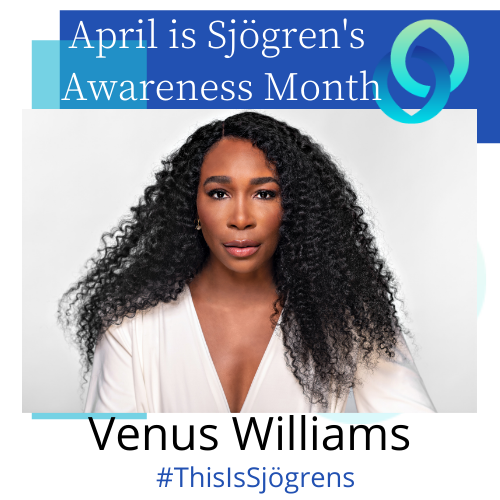
"Sjögren’s is a complex and often invisible disease. As a patient, I was misdiagnosed many times and my symptoms got progressively worse to the point where I couldn’t play professional tennis anymore. I understand the daily struggles and the strength it takes to open up about your journey, but I also know the support and education that is created by awareness. I applaud all the patients who shared their stories during Sjögren’s Awareness Month and everyone who is living with this disease. Your stories have inspired me, and I encourage all patients to continue to talk about their disease and make their health a priority. You are not alone."
- Venus Williams
Thank you Venus Williams and everyone who supported Sjögren’s Awareness Month. Our #ThisIsSjögrens campaign was created to highlight the many faces of Sjögren’s, because as patients, you are the voice and face of the Foundation. It is the collection of your experiences that truly portrays this complex disease.
Click here to learn more.
If you would like to be featured in this year’s April Sjögren's Awareness campaign, you can submit story through the link below. All stories submitted in April are eligible to be highlighted as one of our 30 stories!
Let Your Voice Be Heard!
If you would like your story can be featured in this year's campaign, please submit your story by clicking the link below. 30 stories will be featured in this year's campaign. All stories submitted in April are eligible to be highlighted as one of our 30 stories!

Other Ways to Get Involved:

Are you a member of the Sjögren's Foundation? Click Here for more information.
30 Stories for Sjögren’s Awareness
April is Sjögren’s Awareness Month. Sjögren’s is one of the most prevalent autoimmune diseases, affecting an estimated 4 million Americans. In our #ThisIsSjögrens online campaign, we are featuring 30 real patients to show the impact of this complex disease.
Every day in April, we will highlight a different patient to create a better understanding of the disease. While the daily posts will each give one small glimpse into living with Sjögren’s, by the end of April, we hope these 30 posts will help others understand that the disease is serious, systemic and prevalent.
We encourage you to follow our campaign and remember that every day is an opportunity to start a conversation about Sjögren’s and how it affects you. Together, we will conquer the complexities of Sjögren's!
Carrie Ann Inaba launches Sjögren's Awareness Month #ThisIsSjögrens
Day 1: Carrie Ann Inaba
As a patient, I understand the need to prioritize your health and how important it is to have a strong support system. Often described as an “invisible disease,” Sjögren’s affects patients differently and everyone has a unique and powerful story to share. I am proud to kick-off the #ThisIsSjögrens campaign where 30 real patients will share insight into their Sjögren’s journey. I hope these stories will help create a better understanding of this complex disease and let all patients know that there is support through this community.
Day 2: Ashley 29 (diagnosed at 26)
My most difficult Sjögren’s symptoms are fatigue, dizziness, and brain fog. I wish people truly understood that living with Sjögren’s is not easy. Although, I may not look sick, there are days when I feel awful. Despite all the ups and downs that come with battling this chronic illness, it’s important to practice self-love.
Click here to learn more about living with Sjögren’s.
Day 3: Kara 37 (diagnosed at 35)
Sjögren's is so much more than dry eyes and dry mouth. This disease has taught me to slow down and savor life. If you’re newly diagnosed, allow yourself the time and space to grieve your diagnosis and then get to work on assembling your support network. Learning to ask for help when I need it, has been the biggest act of self-care I have learned.
Click here to learn more about being newly diagnosed with Sjögren’s.
Day 4: Lakisha 37 (diagnosed at 37)
Sjögren's can be a silent disease that you may not know you have. It’s important to be aware of the symptoms and listen to your body. By recording your symptoms, you can better recognize them and learn what treatment options work for you.
Click here to view the Foundation’s Tracking Your Sjögren’s Symptoms Daily Work Sheet
Day 5: D.J. 61 (diagnosed at 45)
My most difficult Sjögren's symptoms are tooth decay from dry mouth and muscle stiffness. I wish people understood that men can be diagnosed with this disease. My best Sjögren’s tip is that you can say no when it’s appropriate. Rest is often the best medicine when in a disease flare.
Click here to learn more about men with Sjögren’s.
Day 6: Meaghan 22 (diagnosed at 12)
Having Sjögren’s from a young age has made a lot of things difficult. Growing up, I often couldn’t keep up with kids my age.
Sjögren's has taught me to always put myself first. I try my best to stay as healthy as possible because when I get sick, I go downhill and it’s a difficult road back to being healthy again!
Click here to learn more about Sjögren's in children.
Day 7: Sophia 31 (diagnosed at 21)
My most difficult Sjögren’s symptoms are chronic pain and fatigue.
This disease has changed my life completely. While I cannot enjoy physical activities like I used to, I am learning to love the woman I am becoming.
Click here to learn more about Sjögren’s and fatigue.
Day 8: Jo 87 (diagnosed at 52)
Although I was diagnosed at 52, I believe I’ve had Sjögren’s for over 60 years. My best Sjögren’s tip is to find a knowledgeable rheumatologist, ophthalmologist, and a good support group!
Click here to learn more about Sjögren’s support groups
Day 9: Jody 52 (diagnosed at 50)
Sjögren's feels a bit like a roller coaster ride with the on again, off again symptoms and variety of problems. It is a lot to handle emotionally and physically. This disease has taught me to advocate for myself, not be afraid to ask questions and speak up for my health.
Click here to learn more about Sjögren's symptoms.
Day 10: Taylor 25 (diagnosed at 11)
Sjögren's can display as an invisible disease for some people. Throughout high school and college, I had debilitating fatigue and struggled every single day, but I fought through it.
I cope with my symptoms by actively advocating for a cure. Sjögren's has taught me that I am a conqueror and together we will conquer Sjögren's.
Learn more about how to join as a Foundation Member and add your voice to ours as we advocate for all patients.
Day 11: Jacqueline 36 (diagnosed at 25)
My dry eye symptoms evolved into corneal ulcers and scarring, which has caused me to go blind in one eye. Sjögren's has taught me humility. I have limitations and that's okay.
I am often emotionally exhausted from the daily struggle of living in a body that is at war with itself. While it can be difficult to talk about Sjögren's, life with this disease is easier with allies.
Click here to learn more about the top 5 things your rheumatologist should be monitoring for.
Day 12: Maci 19 (diagnosed at 15)
Sjögren's has taught me to be someone who isn’t afraid to reach out to others and isn’t ashamed to admit my internal flaws.
It might feel like nobody in the world understands, but there is a community of us who can relate and that is what’s so important about the Sjögren's Foundation.
Today is National Pediatric Sjögren's Awareness Day. Click here to learn more about Childhood Sjögren's.
Day 13: Allison 43 (diagnosed at 41)
Sjögren's affects me every day. I struggle daily with inflammation, joint pain, fatigue, and brain fog. Getting diagnosed was a huge relief and validated that my symptoms weren’t, “just in my head.” Incorporating an anti-inflammatory diet has helped me.
Click here to learn more about Sjögren's and an anti-inflammatory diet.
Day 14: Konisha 47 (diagnosed at 45)
I have been diagnosed with Sjögren's, lupus, and rheumatoid arthritis (RA), which impacts my life a lot more than what is visible to other people. My best Sjögren’s tip is to take it one day at a time.
Click here to learn more about overlapping diseases with Sjögren’s.
Day 15: Jennalee 33 (diagnosed at 25)
When I was pregnant, I was unaware of potential Sjögren's complications. My doctor had to frequently monitor the baby’s heart to ensure that if there was congenital heart block, it was caught and treated early.
I felt very unprepared for the additional testing and frequent monitoring during pregnancy. I hope I can bring raise awareness to this issue.
Click here to learn more about pregnancy and Sjögren's.
Day 16: Lynda 55 (diagnosed at 41)
My most difficult Sjögren's symptoms are dry mouth, difficulty swallowing and painful/swollen parotid glands.This disease has made eating become a chore. I now worry about cutting my food small enough that I don’t choke. I also need to bring water everywhere.
Click here to view the Sjögren's Foundation’s Patient Education Sheet on how to massage salivary glands and click here to view more Sjögren’s Patient Education Sheets.
Day 17: Jack 62 (diagnosed at 59)
During a Sjögren's flare, I often experience MS type symptoms, such as numbness, tingling, pain, fatigue, and light sensitivity.
This disease has taught me to take life one day at a time. While I will have bad days, I try to remember that a good day is coming.
Click here to learn more about a Sjögren's flare.
Day 18: Shannon 24 (diagnosed at 24)
My most difficult Sjögren's symptoms are joint/ muscle pain and dysautonomia. Sjögren's is teaching me to enjoy life and not take my health for granted. I’m learning say “no” when I need to, especially during a flare. My best tip is to find a good support system.
Click here to learn more about Sjögren's support groups, including special support groups.
Day 19: Niki 50 (diagnosed at 42)
My best Sjögren’s tip is to do your own research and be an advocate for yourself. Ask for what you need from family, friends, and healthcare providers. You’re worth it!
I wish people understood how this disease can often be invisible. If you know someone living with Sjögren’s, please be kind when they say they’re exhausted or cannot participate in something.
Learn more about Sjögren's by attending this year’s National Patient Conference.
Day 20: Jess 31 (diagnosed at 28)
Sjögren's has robbed me of the life I dreamed of. It’s expensive to keep up with medications and diet to manage my symptoms.
I wish people knew that I’m in pain almost every single day, but this disease has taught me to speak my truth. I now advocate for myself and others who aren't taken seriously within the medical system.
Click here to learn more about nutrition to improve symptoms of Sjögren's.
Day 21: Tammy 52 (diagnosed at 50)
My most difficult Sjögren’s symptom is full body fatigue. Where it feels like lead weights are tied to you and you really can’t move.
Since being diagnosed, it has been difficult for others to understand my limitations. I wish people knew that I’m doing my best to listen to my body and get through each day.
Click here to learn more about Sjögren’s and fatigue.
Day 22: Patricia 57 (diagnosed at 53)
Living with Sjögren's has taught me that it’s ok to say NO! Don’t feel guilty if you need to rest.
I try my best to be active every day, like walking on the treadmill, because I’m in less pain when I move. While I don’t complain, I wish people would ask me how I’m doing.
Click here to learn more about Sjögren's symptoms.
Day 23: Antiana 22 (diagnosed at 20)
I wish people understood that living with Sjögren's means dealing with multiple symptoms every day. While Sjögren's has impacted my life both physically and emotionally, this disease has taught me to be more confident within myself.
Click here to learn more about living with Sjögren’s.
Day 24: Timothy 53 (diagnosed at 46)
Sjögren's forced me to end my career as a Pennsylvania State Trooper and I am now on disability.
My best tip is to listen to your body and find support in family and friends. It’s important to enjoy what you can, without putting yourself into a disease flare.
Click here to learn more about disability & Sjögren's.
Day 25: Ines 32 (diagnosed at 25)
I wish people understood the complexity of Sjögren's. In order to raise awareness, it’s important to recognize all Sjögren's symptoms. It’s not as simple as, “dry eyes and dry mouth.”
Click here to view Sjögren's Brochures & Resource Sheets.
Day 26: Katie 34 (diagnosed at 28)
My three most difficult Sjögren's symptoms are chronic kidney stones, interstitial cystitis, and joint pain. Sjögren's is a complicated disease and it’s important to appreciate each day. Pilates has been a game changer for me. It helps with my joint pain and peripheral neuropathy.
Click here to learn more about Sjögren's Gynecology and Urology Tips.
Day 27: Cynthia 50 (diagnosed at 49)
Even though you cannot see that I’m sick, physically, I hurt most of the time. My best Sjögren's tip is rest, rest, and more rest! When you need to, don’t feel guilty about resting.
Click here to view Sjögren's survival tips.
Day 28: Ashley 37 (diagnosed at 29)
Sjögren's has taught me my strengths, as well as my weaknesses. My job as a Paramedic is very demanding, and I’ve learned to manage my time/rest. I once feared that I would never be able to have a child due to Sjögren's, but I’m now 28 weeks pregnant with a healthy baby boy. Don’t give up!
Click here to learn more about pregnancy and Sjögren's.
Day 29: Vicki 55 (diagnosed at 53)
Sjögren's impacts every aspect of my life. When I’m having a bad day, I’ve learned to give myself a little self-care. During these days, I sometimes complain and find it hard not cry. My best Sjögren's tip is go easy on yourself and don’t give up hope. Have faith in the Sjögren's Foundation!
Learn more about becoming a member of the Sjögren's Foundation.
"Sjögren’s is a complex and often invisible disease. As a patient, I was misdiagnosed many times and my symptoms got progressively worse to the point where I couldn’t play professional tennis anymore. I understand the daily struggles and the strength it takes to open up about your journey, but I also know the support and education that is created by awareness. I applaud all the patients who shared their stories during Sjögren’s Awareness Month and everyone who is living with this disease. Your stories have inspired me, and I encourage all patients to continue to talk about their disease and make their health a priority. You are not alone."
- Venus Williams
Thank you Venus Williams and everyone who supported Sjögren’s Awareness Month. Our #ThisIsSjögrens campaign was created to highlight the many faces of Sjögren’s, because as patients, you are the voice and face of the Foundation. It is the collection of your experiences that truly portrays this complex disease.
Click here to learn more.
If you would like to be featured in this year’s April Sjögren's Awareness campaign, you can submit story through the link below. All stories submitted in April are eligible to be highlighted as one of our 30 stories!
Let Your Voice Be Heard!
If you would like your story can be featured in this year's campaign, please submit your story by clicking the link below. 30 stories will be featured in this year's campaign. All stories submitted in April are eligible to be highlighted as one of our 30 stories!
Other Ways to Get Involved:
Are you a member of the Sjögren's Foundation? Click Here for more information.